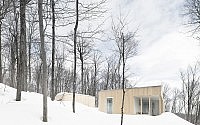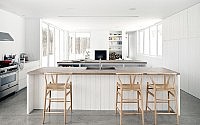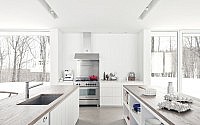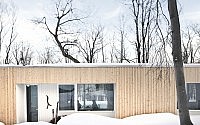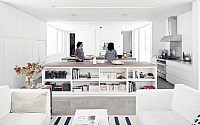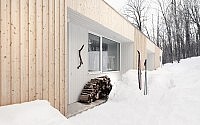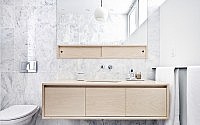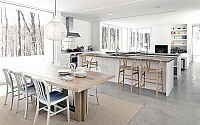Blue Hill’s House by La Shed Architecture
Hidden within the wooded hills in Forestville, Canada, the Blue Hill’s home is a refuge for a family that chose to leave their urban environment for a more natural and spacious setting.


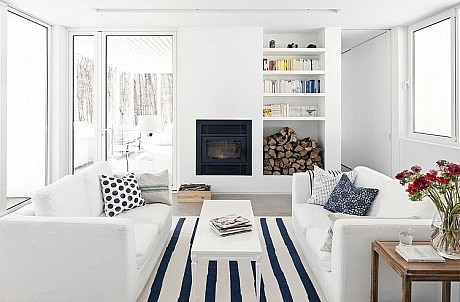
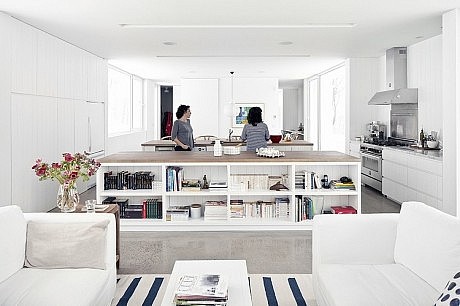
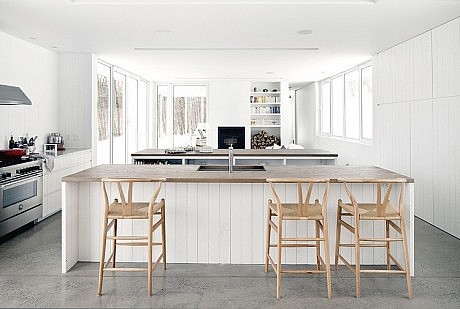
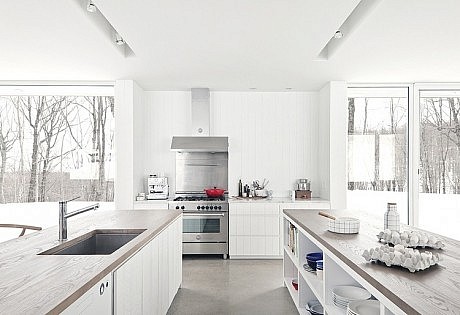
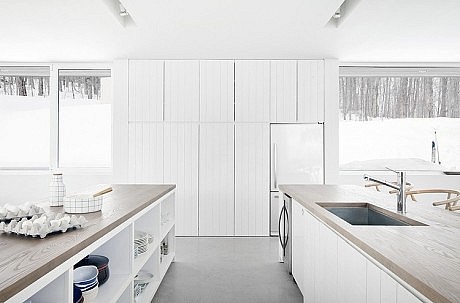
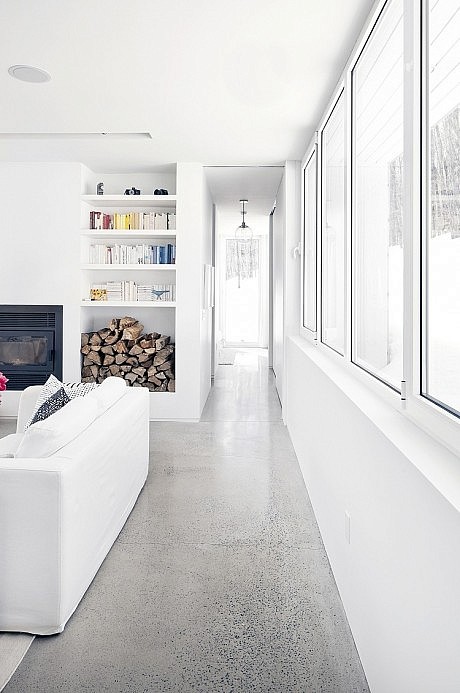
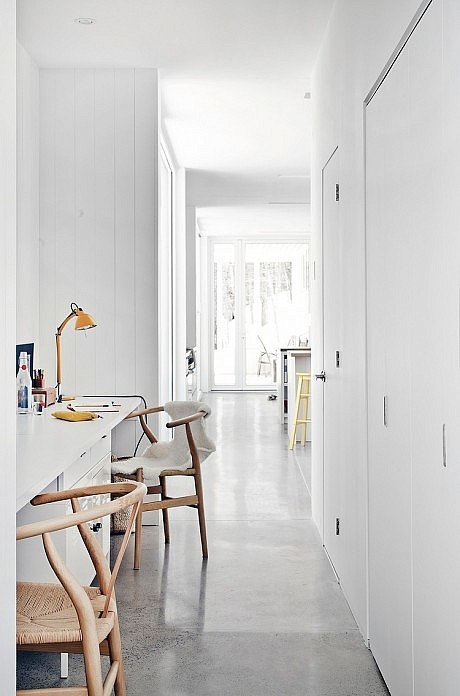
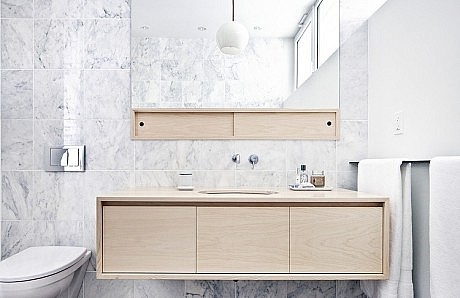
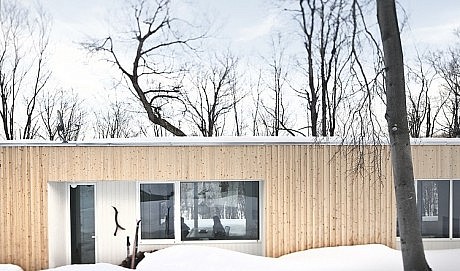
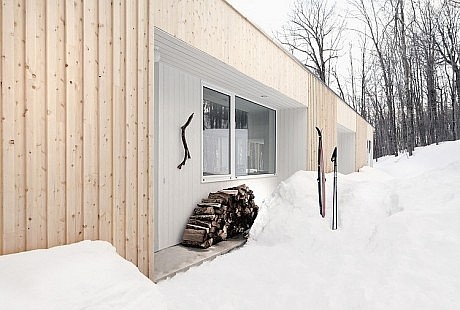
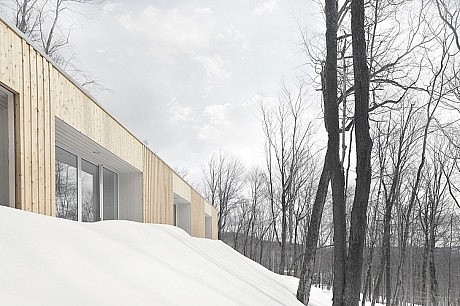
Description by La Shed Architecture
The project consists of a 2300 square foot single family home with an adjoining garage. Perched on a steeply inclined surface over swamps, the single story residence slides gracefully between the trees and is only hardly visible from the street. As per the occupants’ and architect’s wishes, the house has a dual relationship with its environment; from the outside, it is camouflaged in its setting and is as discreet as possible. From the inside, the house is completely open to its surroundings, and its occupants are met with scenery that is in constant evolution. In both cases, the house gives way to the wild grandeur of the Laurentians.
In order to meet this double challenge, a series of tricks were used during project conception.
The exterior walls, entirely covered with vertical eastern cedar slats, will age progressively over the years, emulating the color of the bark of surrounding trees. Certain sections of these walls are covered with wooden slats, thus creating a subtle relief on the facades that interacts with the verticality and rhythm of the surrounding forest. On the flat roof, a bed of river pebbles echoes the colors that can be seen in the adjacent soil; therefore, the structure becomes very difficult to distinguish from its surroundings when observed from the top of the hill.
The fact that this is a single story project allows the house to maintain a minimal height, and thus reduces the footprint on the local environment. Careful attention was also paid to preserving as much of the existing flora as possible. As a result, the linear tapered layout of the building allowed it to sneak into the existing context while diminishing the amount of alterations needed, and also allowed for a minimal difference in height between the front and rear of the house.
This low and straight structural implementation allowed each interior space to have a direct visual link to the vegetation present on the site, and is thus conceived as an extension to the house’s interior flooring. This allows for maximum interaction with the exterior, while optimizing penetration and propagation of natural lighting within the main structure of the home.
Openings on the frontal façades of the building were placed inside a series of alcoves, allowing occupants to open windows even in rainy weather. In addition to serving as protection from inclement meteorological conditions, these alcoves participate in defining a transitional zone between the interior and exterior, a permeable threshold where the white inner walls act as an extension to the house’s interior walls and ceilings. Furthermore, these alcoves block direct sunlight in the summer which protects from overheating due to the large windows while letting through low winter sunlight which contributes to interior heating. This principle works marvelously with the exposed concrete floor that acts as a thermal mass. Given that it is in the shade during the summer, the concrete floor helps cool the house. However, since it is exposed to the sun during the winter time, it contributes to heating the surrounding space by storing solar energy and redistributing it in a uniform fashion thanks to incorporated water pipes.
In order to enter the house, the occupant must pass through an alcove located at the center of the northern façade. The layout is designed in a hierarchal fashion, with common spaces located at the center of the structure and private spaces located at its extremities. Once past the vestibule bounded by a metallic scraper mat, the living spaces are grouped in one place; the kitchen, consisting of two large islands, separates the living room from the dining room. At the very heart of this project, the islands contribute toward making the kitchen a functional and welcoming space. The island adjacent to the dining room contains a lunch counter, whereas the island adjacent to the living room contains a library. These two stretches of furniture therefore act as an interface echoing the functions of spaces adjacent to them. Large openings located at either end of each common space are equipped with full height sliding doors that allow for an even more intimate relationship with nature. The fireplace and integrated furniture are built-in between the alcoves and within partitions in order to clear the central rectangular area and participate in the minimalist aesthetic qualities of the house.
Service spaces are located between the central area and bedrooms in order to create a gradual transitional zone leading toward private spaces. Thus, the bathrooms, utility room and numerous storage spaces filter and absorb noises while sending a signal to the occupant that he is heading for the home’s private spaces.
Materials found within the home evoke the surrounding natural environment. Usage of authentic and raw materials such as the wood on the walls, the marble that envelops the bathrooms or even the polished concrete on the floors ensures that the home will hold long lasting quality. The raw wood coating on the walls was painted white with the purpose of creating a more luminous living space, while preserving the material’s natural texture. This helps create a warm, welcoming and delicate atmosphere that is most coveted by the house’s owners. The whiteness of indoor spaces creates a canvas that changes colors with the surrounding setting as the seasons turn, and allows occupants to experiment with a constantly changing living environment. The atmosphere created by this sober amalgamation of materials and textures provides the house with a uniquely Laurentian character.
The veranda, essentially an extension of the living room, allows occupants to enjoy the outdoor space in what are at times difficult conditions, especially due to harsh weather and the numerous insects present on site. Located on the front façade, this space emulates the typology of surrounding houses which are adorned with spacious porches and verandas.
The Blue Hills House, through its refinement and simplicity, allows for a harmonious coexistence between man and nature. By establishing a comfortable, relaxed and light environment, living in this home is akin to perpetual holiday.
- by Matt Watts